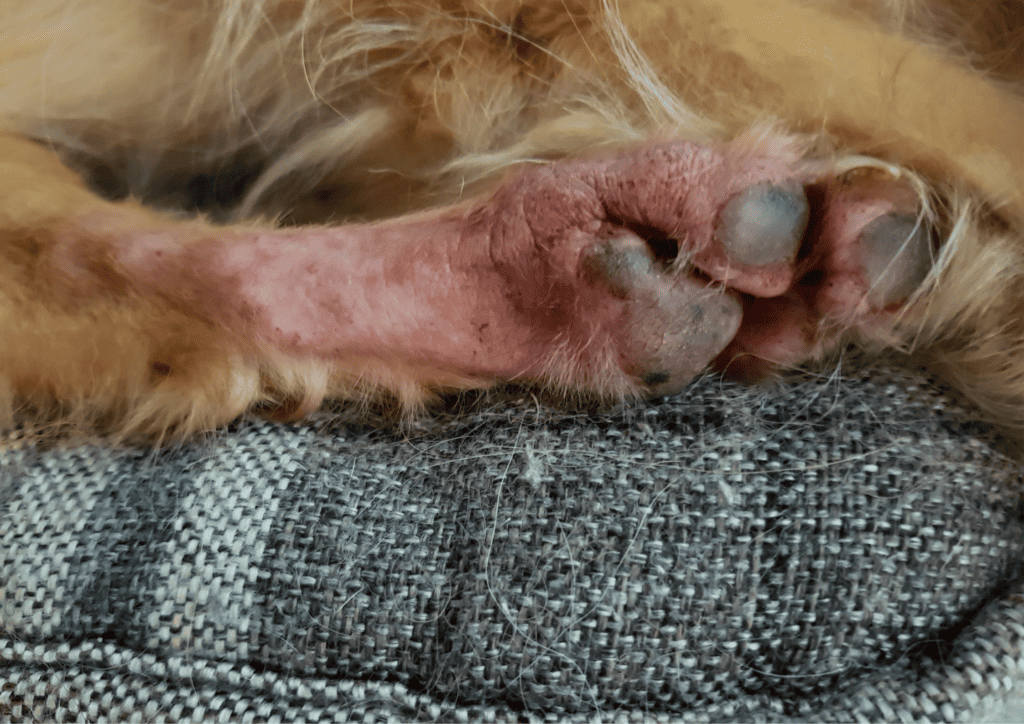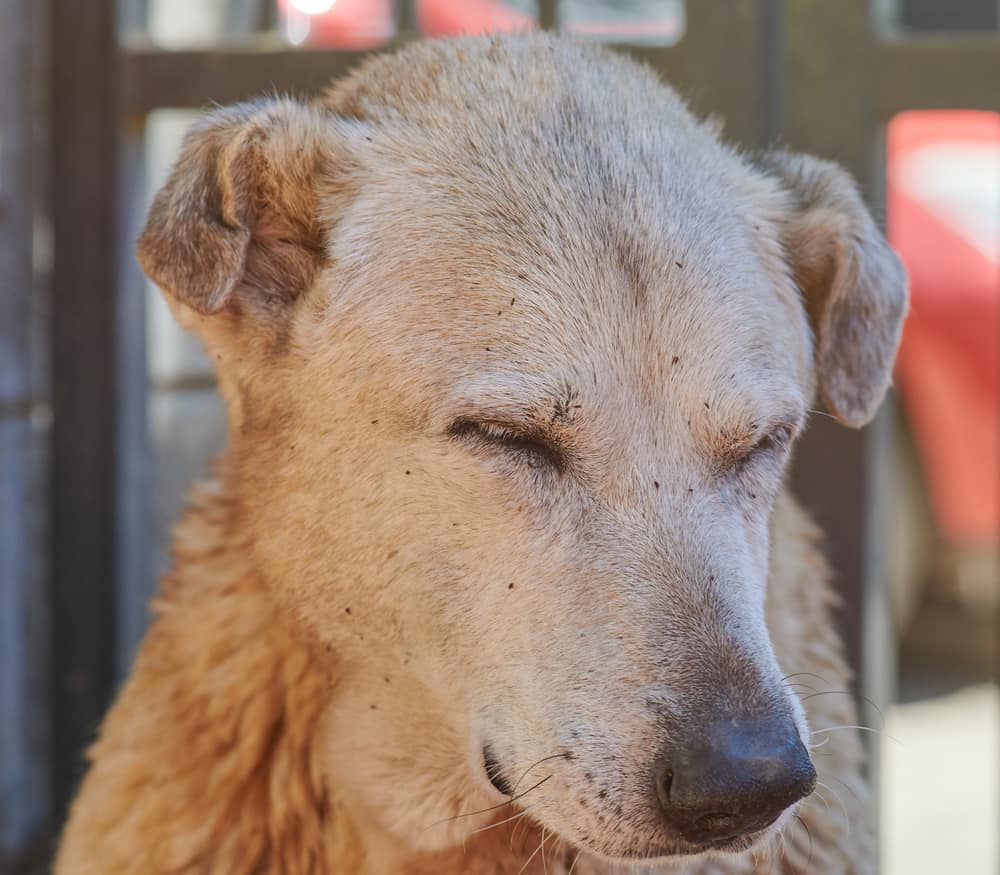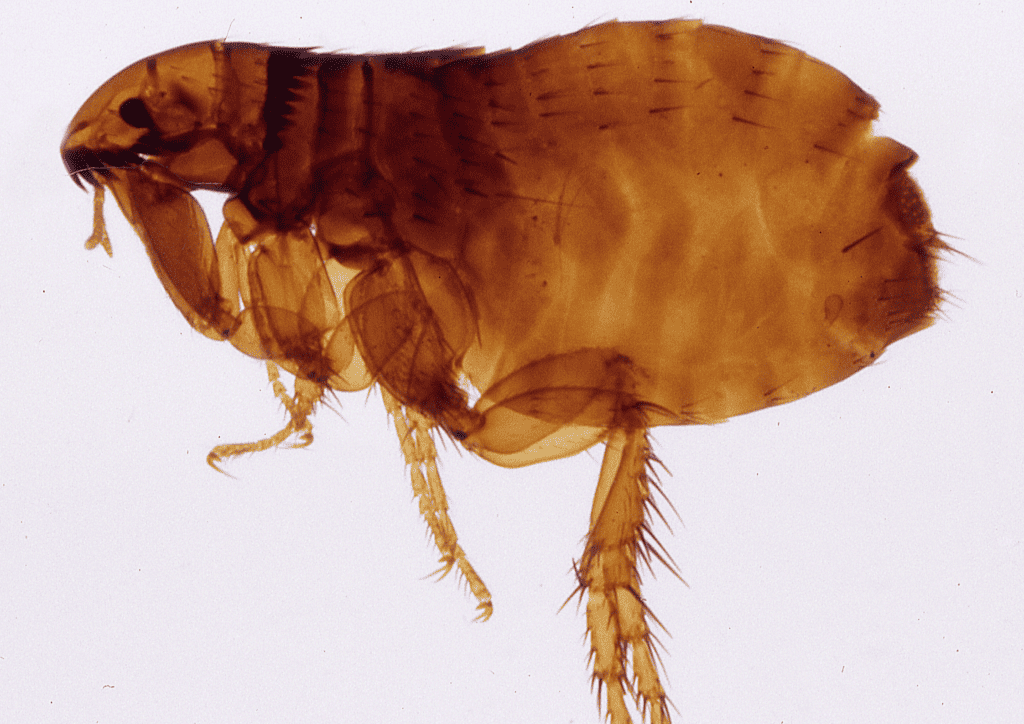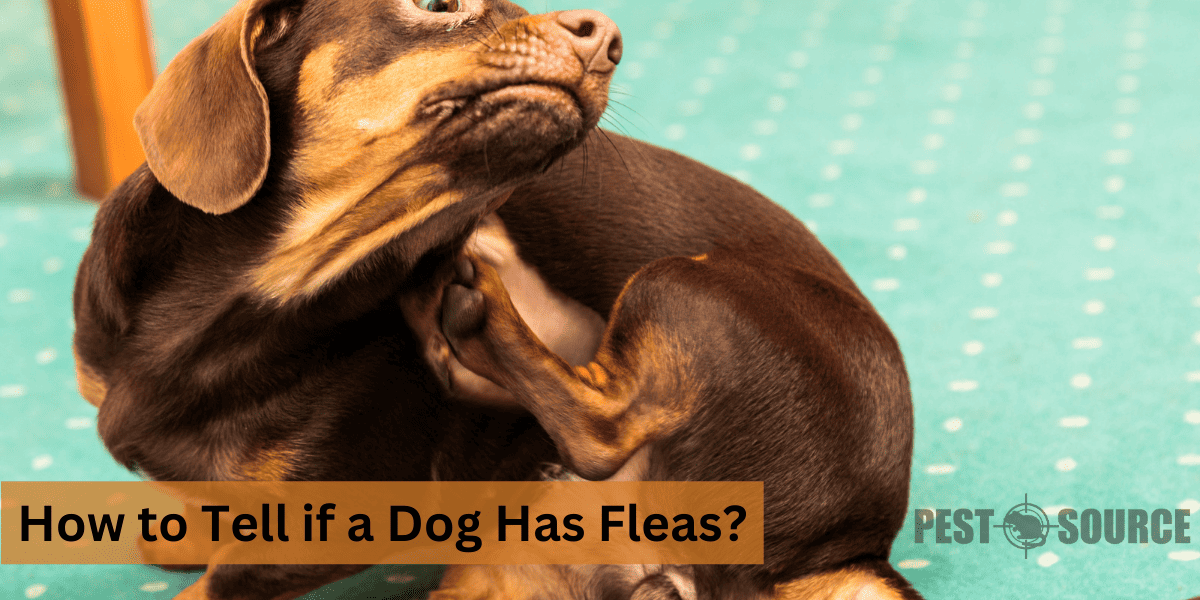Fleas are common parasites that can infest dogs and cause various health issues, including skin irritation, itching, and potential infections. It’s essential to know if your dog has fleas to prevent further complications, control the infestation, and improve your dog’s overall well-being. Timely detection and treatment of fleas can also reduce the likelihood of a more significant infestation in your home, making it a crucial aspect of maintaining a clean and healthy environment for both you and your pets.
POINTS
- Regularly check your dog for fleas by examining their fur and skin for signs such as visible insects, red bumps, and flea dirt, focusing on common hiding spots like the base of the tail, neck, behind the ears, armpits, groin, and between the legs.
- Differentiate between fleas and other issues, such as dry skin or ticks, by noting the distinct characteristics of each issue, such as the mobility and size of the insects, or the presence of flaky skin or attached, blood-engorged pests.
- Treat your dog with flea medication prescribed by your veterinarian, such as oral tablets, topical treatments, flea collars, or shampoos, and make sure all household pets receive simultaneous treatment.
- Address flea infestations in your home by regularly vacuuming carpets, rugs, and upholstery, washing pet bedding and toys in hot water, and potentially using flea foggers or professional pest control services when necessary.
- Maintain a year-round preventive flea control program for your pets, including oral or topical treatments or flea collars, regular grooming, and regular home cleaning to minimize the risk of future infestations.
What are the Common Signs and Symptoms of Fleas in Dogs?
Understanding the signs and symptoms of flea infestations in dogs is crucial for timely intervention and treatment. The following table outlines common indicators of fleas, providing a clear guide to help you quickly identify if your dog might be affected.
| Symptom | Description | Affected Area |
|---|---|---|
| Red bumps | Small, raised, and sometimes scabbed bumps that indicate flea bites. | Base of the tail, groin, belly, legs |
| Flea dirt | Small black specks that turn red or brown when wet, indicating flea feces. | Throughout the fur |
| Excessive scratching or biting | Dogs may scratch, bite, or lick their skin more than usual due to irritation. | Areas with flea activity |
| Hair loss | Loss of hair from excessive scratching or biting. | Near the site of flea bites |
| Restlessness | Discomfort from flea bites can make dogs unusually restless. | General behavior |
| Allergic reactions | Some dogs may have an allergic reaction to flea saliva, known as flea allergy dermatitis, causing intense itching and inflammation. | Skin, especially around bites |
How can you Recognize Flea Bites on Dogs?
Flea bites can cause red, raised, and sometimes scabbed bumps on your dog’s skin. These bites are often concentrated in specific areas, such as the base of the tail, groin, belly, or on the legs. The affected areas may also appear swollen, irritated, and show signs of hair loss due to excessive scratching or biting.
What are the Visible Symptoms of Fleas in Dogs?

In addition to flea bites, you may also notice other visible symptoms such as flea dirt (small black specks that resemble pepper), which is actually flea feces consisting of your dog’s dried blood. To confirm if it’s flea dirt, use a white paper towel to gently rub the specks from your dog’s fur. If the spots turn red or brown when wet, it’s likely flea dirt. Other visible symptoms may include rashes, scabs, and bald patches resulting from continuous itching and scratching.
Are There Behavioral Signs that Indicate a Dog has Fleas?
Dogs infested with fleas will exhibit specific behaviors due to the discomfort and irritation caused by the parasites. Signs that your dog might have fleas include excessive scratching, biting, or licking their skin, restlessness, and agitation. Some dogs might also develop an allergic reaction to flea saliva, known as flea allergy dermatitis, which can cause intense itching and inflammation.

Can You See Fleas on Dogs?
What Do Fleas Look Like on Dogs?

Fleas are small, flat, wingless insects that are about the size of a pinhead. On dogs, fleas might appear as tiny, dark, fast-moving specks crawling through your dog’s fur. You may also spot white flea eggs, which look like grains of salt.
What Does a Dog Flea Look Like?

Dog fleas are dark brown or reddish-brown in color and have six legs with strong claws that help them navigate through your dog’s fur. They have sharp, tube-like mouthparts that pierce the skin and feed on your dog’s blood. Fleas can jump long distances, making them difficult to catch.
What Does a Dog with Fleas Look Like?

A dog with fleas will often exhibit visible symptoms and behaviors of discomfort, such as itching, biting, scratching, and restlessness. You might also notice bald patches, rashes, and skin inflammation due to the excessive scratching.
Are Fleas Visible on Dogs?
While fleas are small and may be difficult to spot at first, they are visible to the naked eye. Comb through your dog’s fur using a fine-toothed comb to search for fleas or flea dirt, focusing on common hiding spots such as the neck, behind the ears, and the base of the tail.
Where Do Fleas Hide and Live on Dogs?
Where Do Fleas Hide on Dogs?
Fleas are adept at finding the most concealed and warm spots on a dog’s body to hide, live, and breed. Knowing these common hiding places is crucial for effective flea detection and control. Here are the key areas to check:
- Base of the Tail: Fleas often hide in the warm, protected area around the base of a dog’s tail.
- Neck: The neck, especially under the collar, provides a convenient hiding spot for fleas.
- Behind the Ears: This is another warm area that fleas prefer, due to the lesser likelihood of being disturbed.
- Armpits: The armpits (or axillae) of dogs offer warmth and protection, making them attractive to fleas.
- Groin: The groin area’s warmth and moisture attract fleas looking for a place to hide and reproduce.
- Between the Legs: Fleas can hide between a dog’s legs, where the fur is denser and offers protection from grooming.
Where Do Fleas Live on Dogs?

Fleas live directly on your dog’s body, feeding on their blood and laying eggs that fall off and infest your home. A single female flea can lay up to 50 eggs per day, which hatch and develop into larvae and eventually mature fleas. These new fleas jump back onto your dog to continue the infestation cycle. It’s crucial to address any fleas on your pet promptly to prevent the infestation from spreading throughout your home.
Where to Look for Fleas on Dogs?
When checking your dog for fleas, focus on the common hiding spots to increase your chances of finding them. Use a flea comb to gently part the fur and get a better view of the skin. Check the base of the tail, neck, behind the ears, under the collar, armpits, groin, and between the legs. Additionally, examine your dog’s bedding and other areas where they spend time for signs of fleas or flea dirt.
How Do You Check for Fleas on Dogs?
How to Check a Dog for Fleas?

Checking your dog for fleas is a necessary part of pet care, especially if your dog is exhibiting signs of discomfort or irritation. Below is a step-by-step guide in table form to assist you in thoroughly inspecting your dog for fleas, ensuring you don’t miss these tiny pests.
| Step | Description | Tools Needed |
|---|---|---|
| Preparation | Place your dog on a white sheet or towel to catch any falling fleas or flea dirt during examination. | White sheet or towel |
| Combing | Gently comb through your dog’s fur with a fine-toothed flea comb, paying special attention to common flea hiding spots. | Fine-toothed flea comb |
| Observation | Look for fleas, flea dirt, or flea eggs on the comb and the white sheet or towel after each pass. | Good lighting |
| Flea Dirt Test | Wet any specks found to see if they turn red or brown, indicating flea dirt. | Water, paper towel |
| Flea Removal | Drown any fleas caught on the comb in a bowl of soapy water to kill them. | Bowl of soapy water |
| Repeat Checks | Regularly check your dog for fleas, especially during warm months or if your dog has been in contact with other animals. | Consistency, vigilance |
How Can You Differentiate Between Fleas and Other Issues such as Dry Skin or Ticks?
Differentiating between fleas and other skin conditions in dogs is essential for providing the right treatment and care. The table below compares fleas with other common issues such as dry skin or ticks, highlighting key differences to aid in accurate diagnosis.
| Issue | Symptoms | Fleas Signs | Other Issue Signs |
|---|---|---|---|
| Fleas | Itching, red bumps, flea dirt | Visible insects, flea dirt turns red when wet | N/A |
| Dry Skin | Flaky skin, dull coat, itching | No visible insects or flea dirt | Flaky, dandruff-like shedding |
| Ticks | Itching, visible bump on the skin | Fleas are smaller and jump | Ticks are larger, attach to the skin |
| Allergies | Itching, red skin, possibly swelling | May have flea dirt if fleas are the cause | Symptoms persist without flea evidence |
| Mites | Intense itching, hair loss, scaly skin | No visible insects or flea dirt | Tiny, spider-like parasites on skin |
| Fungal Infections | Circular, scaly patches, hair loss | No visible insects or flea dirt | Ring-like lesions, often with a clear center |
How to Tell if a Dog Has Fleas or Just Dry Skin?

Dry skin and flea infestations can sometimes appear similar, but there are a few key differences. Dry skin often causes flaky, dandruff-like shedding, especially during the colder months or due to a nutritional deficiency. Flea infestations result in visible fleas, flea dirt, and small red bumps on the skin due to the bites. When in doubt, consult a veterinarian for a professional evaluation.
How to Know if Your Dog Has Fleas or Ticks?

Ticks are larger than fleas and attach themselves to your dog’s skin, becoming engorged with blood over time. Additionally, ticks cannot jump or move like fleas and do not cause the same level of itching as a flea infestation. If you find a small, attached insect on your dog’s skin, it’s more likely to be a tick rather than a flea. Remove the ticks with a pair of fine-tipped tweezers, and consult your veterinarian for guidance on potential diseases transmitted by ticks.
How to Detect Fleas on Dogs vs. Other Skin Conditions?
Thoroughly inspect your dog’s skin and fur for signs of fleas, such as flea dirt or the insects themselves. If you are unsure whether your dog has fleas or suffers from another skin condition, consult your veterinarian, who can diagnose the issue, provide guidance on the appropriate treatment, and recommend preventive measures to avoid future infestations or skin issues.
Are There Differences in Checking for Fleas on Puppies vs Adult Dogs?
How to Tell if a Puppy Has Fleas?
While the signs of flea infestations are similar in both puppies and adult dogs, puppies might be more sensitive to flea bites due to their still-developing immune system. Additionally, severe infestations in puppies can lead to anemia as fleas feed on their blood. When checking a puppy for fleas, be gentle and thorough, using a fine-toothed flea comb. Focus on the common hiding spots mentioned earlier and keep an eye out for any signs of irritation or excessive scratching.
How to Know if a Puppy Has Fleas?

One way to determine if your puppy has fleas is by observing their behavior. If they are constantly scratching, biting, or rubbing against surfaces, it could be due to fleas. Visually inspect your puppy’s fur and skin for any traces of fleas, flea dirt, or flea eggs. If you’re unsure, consult your veterinarian for a professional assessment.
How Do I Know if My Puppy Has Fleas?
If you see small, quick-moving insects in your puppy’s fur or any signs of skin irritation, such as red bumps or scabs, your puppy likely has fleas. Additionally, if your puppy has had contact with other animals or environments that might be infested with fleas, you should regularly check for any signs of fleas.
Conclusion: What Steps Should You Take if Your Dog Has Fleas?
If you discover that your dog has fleas, take the following steps to control the infestation and prevent future issues:
- Start a flea treatment plan: Consult your veterinarian for advice on the best flea treatment options for your dog, such as oral tablets, topical treatments, flea collars, or shampoos. Ensure all pets in your household are treated simultaneously to eliminate fleas effectively.
- Treat your home: Vacuum your carpets, rugs, upholstery, and your pet’s bedding frequently to remove flea eggs and larvae. Wash your pet’s bedding, toys, and any washable household items in hot water to kill the fleas and their eggs. In cases of severe infestations, you may need to use a flea fogger or consult a professional pest control service.
- Maintain a regular preventive flea control program: Keep your dog on a year-round flea prevention plan as recommended by your veterinarian. This can include oral or topical treatments or flea collars. Regular grooming, such as bathing and combing, can also help manage potential infestations.
By promptly recognizing the signs of fleas in dogs and taking the appropriate steps to control and prevent infestations, you can ensure a comfortable and healthy life for your beloved pets and maintain a flea-free home for you and your family.



